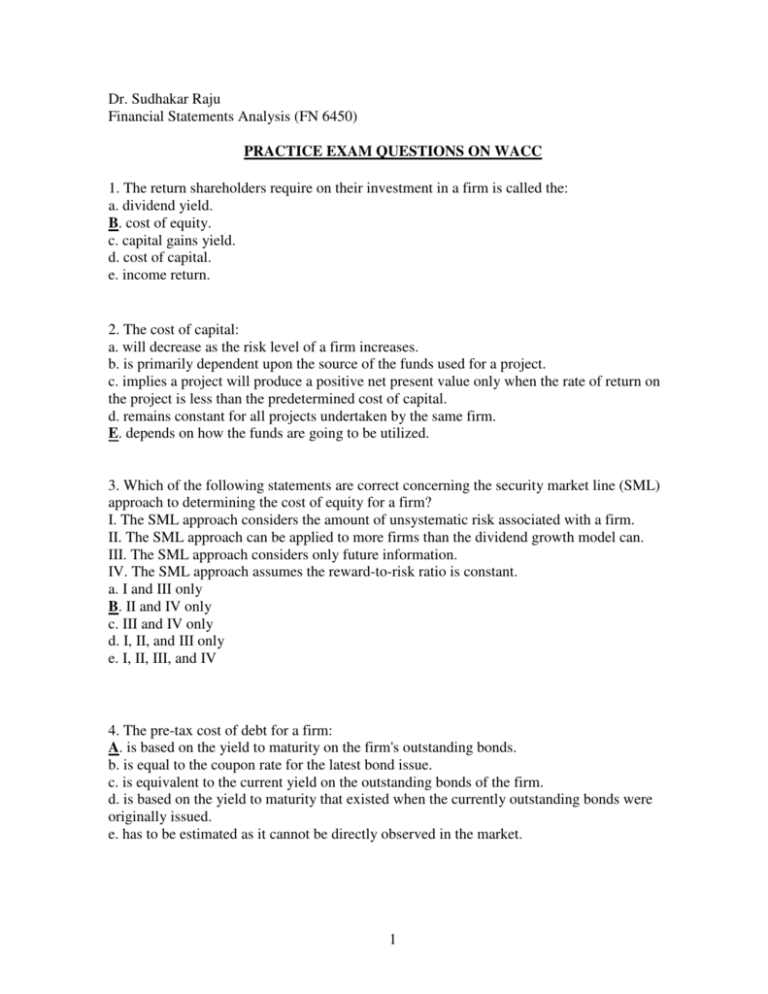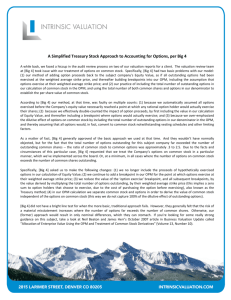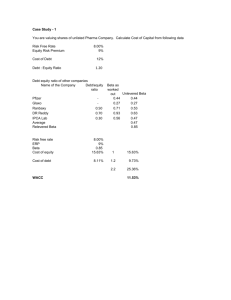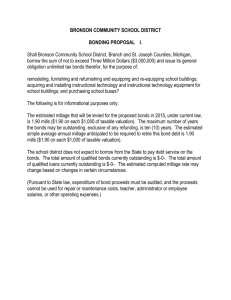PRACTICE EXAM QUESTIONS ON WACC
advertisement

Dr. Sudhakar Raju Financial Statements Analysis (FN 6450) PRACTICE EXAM QUESTIONS ON WACC 1. The return shareholders require on their investment in a firm is called the: a. dividend yield. B. cost of equity. c. capital gains yield. d. cost of capital. e. income return. 2. The cost of capital: a. will decrease as the risk level of a firm increases. b. is primarily dependent upon the source of the funds used for a project. c. implies a project will produce a positive net present value only when the rate of return on the project is less than the predetermined cost of capital. d. remains constant for all projects undertaken by the same firm. E. depends on how the funds are going to be utilized. 3. Which of the following statements are correct concerning the security market line (SML) approach to determining the cost of equity for a firm? I. The SML approach considers the amount of unsystematic risk associated with a firm. II. The SML approach can be applied to more firms than the dividend growth model can. III. The SML approach considers only future information. IV. The SML approach assumes the reward-to-risk ratio is constant. a. I and III only B. II and IV only c. III and IV only d. I, II, and III only e. I, II, III, and IV 4. The pre-tax cost of debt for a firm: A. is based on the yield to maturity on the firm's outstanding bonds. b. is equal to the coupon rate for the latest bond issue. c. is equivalent to the current yield on the outstanding bonds of the firm. d. is based on the yield to maturity that existed when the currently outstanding bonds were originally issued. e. has to be estimated as it cannot be directly observed in the market. 1 5. The capital structure weights used in computing the weighted average cost of capital: a. are based on the book values of total debt and total equity. B. are based on the market value of the firm's debt and equity securities. c. are computed using the book value of the long-term debt and the book value of equity. d. remain constant over time unless the firm issues new securities. e. are restricted to the firm's debt and common stock. 6. DTK, Inc. uses both preferred and common stock as well as long-term debt to finance its operations. An increase in which one of the following will increase the capital structure weight of debt, all else equal? a. market price of the common stock b. number of shares of preferred stock outstanding c. book value of the outstanding shares of common stock D. number of bonds outstanding e. number of shares of stock outstanding 7. The weighted average cost of capital for a firm is the: a. discount rate which the firm should apply to all of the projects it undertakes. B. rate of return a firm must earn on its existing assets to maintain the current value of its stock. c. coupon rate the firm should expect to pay on its next bond issue. d. maximum rate which the firm should require on any projects it undertakes. e. required rate which every project's internal rate of return must exceed. 8. Which one of the following statements is correct concerning the weighted average cost of capital (WACC)? A. The WACC may decrease as a firm's debt-equity ratio increases. b. When computing the WACC, the weight assigned to the preferred stock is based on the coupon rate multiplied by the par value of the stock. c. A firm's WACC will decrease as the corporate tax rate decreases. d. The weight of the common stock used in the computation of the WACC is based on the number of shares outstanding multiplied by the book value per share. e. The WACC will remain constant unless a firm retires some of its debt. 2 9. Flotation costs should: a. be ignored when analyzing a project because flotation costs are not an actual cost of the project. b. be averaged over the life of the project thereby reducing the cash flows for each year of the project. c. only be considered when two projects have the same net present value. D. be included in the initial cost of a project before the net present value of the project is computed. e. be ignored totally when internal equity funding is utilized. 10. Cameron Industries is expected to pay an annual dividend of $1.30 a share next month. The market price of the stock is $24.80 and the growth rate is 3 percent. What is the firm's cost of equity? a. 7.58 percent b. 7.91 percent C. 8.24 percent d. 8.40 percent e. 8.76 percent 11. Old Country Lemonade has a beta of .9, a stock price of $28, and recently paid an annual dividend of $1.10 a share. The dividend growth rate is 3 percent. The market has an 11 percent rate of return and a risk premium of 7 percent. What is the average expected cost of equity for Old Country Lemonade? a. 7.05 percent B. 8.67 percent c. 9.13 percent d. 10.30 percent e. 11.33 percent 3 12. HBS, Inc. has a growth rate of 6 percent and is equally as risky as the market. The stock is currently selling for $15 a share. The overall stock market has a 12 percent rate of return and a risk premium of 9 percent. What is the expected rate of return on HBS's stock? a. 6 percent b. 9 percent C. 12 percent d. 15 percent e. 18 percent Re = (.12 .09) + (1.00 .09) = 12.00 percent 13. The Collection Co. has a current beta of 1.6. The market risk premium is 7 percent and the risk-free rate of return is 3 percent. By how much will the cost of equity increase if the company expands their operations such that their company beta rises to 1.9? a. 0.30 percent b. 0.90 percent c. 1.50 percent D. 2.10 percent e. 2.70 percent Increase in cost of equity = (1.9 1.6) .07 = 2.10 percent 14. The Lawson Company has a seven-year bond outstanding with a 6 percent coupon. Interest payments are paid semi-annually. The face amount of the bond is $1,000. This bond is currently selling for 101 percent of its face value. What is the company's pre-tax cost of debt? a. 4.33 percent b. 4.49 percent c. 5.68 percent D. 5.82 percent e. 5.91 percent 4 15. Ellie's Boutique has a bond issue outstanding that matures in fourteen years. The bonds pay interest semi-annually. Currently, the bonds are quoted at 98 percent of face value and carry an 8 percent coupon. The firm's tax rate is 35 percent. What is the firm's aftertax cost of debt? a. 2.88 percent B. 5.36 percent c. 5.45 percent d. 8.24 percent e. 10.72 percent 16. Antonio's Pizzeria has 8 percent preferred stock outstanding that sells for $71 a share. This stock was originally issued at $58 per share. What is Antonio's cost of preferred stock? a. 8.00 percent b. 10.50 percent C. 11.27 percent d. 13.79 percent e. 16.00 percent CPS = (.08 $100) / $71 = 11.27 percent 17. The Seasing Company has 1,500 bonds outstanding that are selling for $1,060 each. The company also has 5,000 shares of preferred stock at a market price of $32 each. The common stock is priced at $26 a share and there are 36,000 shares outstanding. What is the weight of the common stock as it relates to the firm's weighted average cost of capital? a. 6 percent B. 35 percent c. 41 percent d. 54 percent e. 60 percent 5 18. Highpark Industrial has a $500,000 bond issue outstanding that is selling at 96 percent of face value. Highpark also has 6,500 shares of preferred stock and 22,000 shares of common stock outstanding. The preferred stock has a market price of $50 a share compared to a price of $35 a share for the common stock. What is the weight of the preferred stock as it relates to the firm's weighted average cost of capital? a. 9 percent b. 13 percent c. 17 percent D. 21 percent e. 26 percent 19. The Basket Weavers Company has 100,000 bonds outstanding that are selling at par value. Bonds with similar characteristics are yielding 7.5 percent. The company also has 1 million shares of 10.5 percent preferred stock outstanding and 5 million shares of common stock outstanding. The preferred stock sells for $56 per share. The common stock has a beta of 1.2 and sells for $38 a share. The U.S. Treasury bill is yielding 3 percent and the return on the market is 12 percent. The corporate tax rate is 34 percent. What is Basket Weaver's weighted average cost of capital? a. 10.71 percent B. 12.04 percent c. 12.78 percent d. 14.02 percent e. 14.85 percent 6 20. Cruiseliners, Inc. has 230,000 shares of common stock outstanding at a market price of $40 a share. Next quarter, Cruiseliners' is expected to pay an annual dividend in the amount of $1.80 per share. The dividend growth rate is 3 percent. Cruiseliners' also has 8,000 bonds outstanding with a face value of $1,000 per bond. The bonds carry a 9 percent coupon, pay interest annually, and mature in 5.093 years. The bonds are selling at 102 percent of face value. The company's tax rate is 35 percent. What is Cruiseliners' weighted average cost of capital? a. 5.4 percent B. 6.6 percent c. 7.5 percent d. 8.5 percent e. 9.6 percent 21. Great Sound Music, Inc. has 20,000 shares of common stock outstanding at a market price of $26 a share. This stock was originally issued at $19 per share. The firm also has a bond issue outstanding with a total face value of $300,000 which is selling for 97 percent of face value. The cost of equity is 10 percent while the after tax cost of debt is 5 percent. The firm has a beta of 1.2 and a tax rate of 35 percent. What is Great Sound's weighted average cost of capital? a. 7.07 percent b. 7.58 percent c. 7.83 percent d. 8.16 percent E. 8.21 percent 7 WACC = [($520,000 / $811,000) .08206 = 8.21 percent .10] + [($291,000 / $811,000) .05] = .06412 + .01794 = 22. Hilltop, Inc. has a capital structure which is based on 30 percent debt, 10 percent preferred stock, and 60 percent common stock. The pre-tax cost of debt is 8 percent, the cost of preferred is 9 percent, and the cost of common stock is 11 percent. The company's tax rate is 34 percent. The company is considering a project that is equally as risky as the overall firm. This project has initial costs of $250,000 and cash inflows of $94,000 a year for three years. What is the projected net present value of this project? a. $15,823.76 B. $12,414.07 c. $9,127.53 d. $1,083.19 e. $15,823.76 23. Keller's Korner is considering a new project they consider to be a little riskier than their current operations. Thus, management has decided to add an additional 2.5 percent to their company's overall cost of capital when evaluating this project. The project has an initial cash outlay of $30,000 and projected cash inflows of $12,000 in year one, $20,000 in year two, and $8,000 in year three. The firm uses 40 percent debt and 60 percent common stock as their capital structure. The company's cost of equity is 14 percent while the aftertax cost of debt for the firm is 7 percent. What is the projected net present value of the new project? A. $1,467.38 b. $2,360.46 c. $2,783.50 d. $3,904.59 e. $3,561.58 8 24. The Warren Co. has a capital structure which is based on 20 percent debt, 35 percent preferred stock, and 45 percent common stock. The flotation costs are 9 percent for common stock, 10 percent for preferred stock, and 5 percent for debt. The corporate tax rate is 34 percent. What is the weighted average flotation cost? a. 6.79 percent b. 7.55 percent c. 8.21 percent D. 8.55 percent e. 9.05 percent Average flotation cost = (.45 = 8.55 percent .09) + (.35 .10) + (.20 .05) = .0405 + .035 + .01 = .0855 25. Harmon, Inc. has a debt-equity ratio of .80. The firm is analyzing a new project which requires an initial cash outlay of $300,000 for new equipment. The flotation cost for new equity is 9 percent and for debt 4.5 percent. What is the initial cost of the project including the flotation costs? a. $317,125 b. $320,856 c. $321,000 D. $322,581 e. $325,912 9






